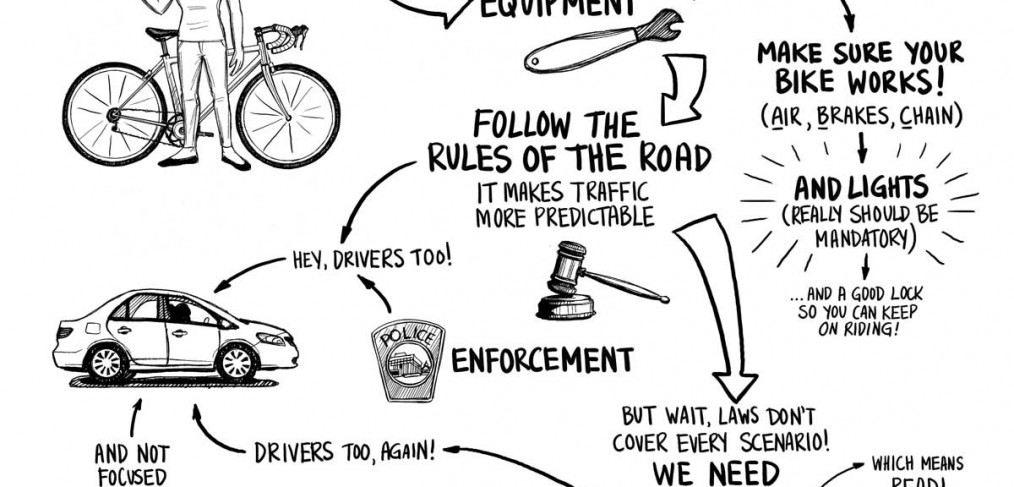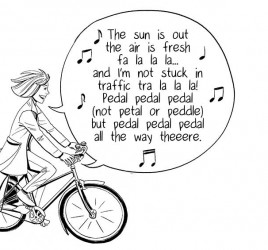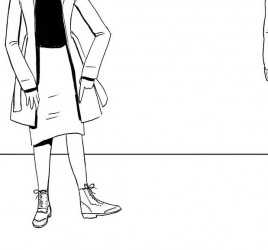
Serious about Safety
Every bike commuter knows is that safety is a complicated issue. They face it every day. However, some safety campaigns focus entirely on helmets. But that means there’s been a crash. What if it could have been prevented? Wouldn’t that be safer?
There’s many points along the way where an individual, a community, and a city, can prevent more tragedies from happening. Helmet or not, when you put a car against a vulnerable road user, you know who the victim will be. Cities need to get real about safety. No excuses.





I just came here because the Patch linked me here. The cartoons are great, but God, what pains in the ass most of you people are. No wonder so many people hate bike riders. To address one of the past cartoons, just get out of way of the guy trying to turn right for goodness’ sake. What point are you making by not getting out of someone’s way? Otherwise just ride carefully, which has worked for me all over the world for 50 years — somehow I have managed to survive with a crew of Danish PhDs or whatever studying my every move and advising me. PS just wear the damn helmet too.
Get out of the way of the guy turning right? Sure. As soon as he has priority (as determined by the rules of the road (remember those?), we’ll get out of his way. But while we have priority, ‘his way’ belongs to the vehicle in front, and if that’s a cyclist, he must wait. That’s not my rule – it’s the law in every state.
Some folks need to read their driver’s handbook. Re-taking the driving test might help too. Also, the traffic laws of each state are online nowadays, so there’s no excuse for not knowing the law – at least not for anyone who can post here.
That guy who wants to turn right, you know we’re not the least bit required to get out of his way, right? But I do often move to let people past, but I have some conditions.
First, you have to use your signal. If you don’t use your signal, how can I know that you want to turn right? It’s also really important to safety; if I’m rolling up on the right, that signal lets me know that I don’t want to be beside you. So it should be a habit, all the time.
Second, if I don’t know the cycle for the light, or if I know it is about to turn green, I’m not going to do it, because it might not be safe for me. It’s not safe to do non-standard things around cars that are in motion, or about to be in motion.
Third, am I in a good mood? Honking doesn’t help my mood, but you knew that, right?
And yeah, I know, this lackadaisical attitude towards the Rules Of The Road drives vehicularists up a tree, but let’s get real. I’m not going to get hit, scooching my bike over to the left in stopped traffic so someone can squeeze by, or riding back around and behind the guy who wants to turn, and I already checked the light to be sure it would be red for a while. This is all slow-speed stuff (which, as we read above, is what makes the Dutch so safe, and not their wonderful infrastructure). I figure, I cut you some slack on right turns, maybe you’ll be less anal about my Idaho stops.
Hi! First-time visit to the site and I love your art! (It’s true about the 1000-words vs 1 picture thing, isn’t it.)
@ Ian,
“The notion that motorists and cyclists are in some sort of competition or ‘match’ on the road is false.”
“It’s not a competition. There are no ‘opponents’ on the road and no one ‘wins’ anything.”
Tell motorists that! Indeed, you seem to contradict yourself: “Their major problem is that they believe cyclists don’t belong on ‘their’ roads.” Yup, no competition: the motorist rules. :-p
“That’s probably why [the Dutch] are safer than anyone else (if indeed they are…)”
Do you have any idea how benighted and naïve you sound? You’ve been in the US too long, Ian. Visit the Netherlands. See for yourself. Please!
“If everyone acts responsibly and obeys [right of way] rules, the road is perfectly safe for cyclists.”
The idea of sharing a road with motor vehicles is intimidating and scary for the vast majority of people. Hence, they don’t ride. I agree that training does have a place in safe riding (the Dutch all get lessons at school as well as lessons from their parents) – but riding with motor vehicles will always remain intimidating and scary. Like swimming with sharks or running with bulls or any other extreme sport.
“Off in infrastructure land, you get all these gratuitous hazards (the lovely, but dangerous, granite posts that DCR puts in the middle of their new paths) as well as thoughtless stuff (misaligned old-style sewer grates, [unpatched potholes, ill maintained]”
No-one here is arguing for BAD infrastructure. Straw man.
If you’re going to quote Jensen (2007) to us, get your facts straight. You cite a 10% increase in crashes and injuries. This is for ALL injuries (pedestrians, mopeds, bicycles, motor vehicle crashes) on the street with the new bicycle track. Read the discussion section: Jensen notes that the bicycle facilities had a ‘rather large’ effect on traffic volumes that indicate ‘thousands of travelers [sic] in total must have changed their choice of transport mode’. He notes a ‘20% increase in bicycle/moped mileage’ and a ‘decrease of 10% in motor vehicle traffic mileage’. Jensen suggests that these modal changes resulted in ‘higher vehicular speed, increased crossing activity by pedestrians outside formal crossings, etc.’ Making corrections for changes in traffic volumes, ‘the safety effect [improves], because the bicycle traffic has increased.’ In other words: bicycle numbers rose 20%, all injuries (including pedestrians and mopeds) rose only 10%. OVERALL RISK therefore fell.
Several studies have reached this conclusion: as more people ride, overall risk of cycling decreases – the total number of injuries to riders rises, but less than what would be predicted from the initial risk. (See Ekman, Lars (1996); Ministerium für Wirtschaft und Mittelstand, Energie und Verkehr des Landes Nordrhein-Westphalen (2001); Jensen, Søren Underlien (1998); Jacobsen, P L (2003); UITP/ European Cyclists’ Federation (1997, December). )
Here in New Zealand we saw the opposite when the helmet law came in: the government were quick to point to the TOTAL numbers in claiming that law caused a 19% reduction in cyclist head injuries. Compared however to the number of cyclists freefalling 22%, the OVERALL RISK of head injuries rose.
Adam
Ahoy, on the bad infrastructure, we’re in violent agreement. The issue/worry is that things have to be spelled out in detail for car-centric planners and designers, because look at all the crud that they do already. We say “infrastructure”, they think “skinny bike lane next to parked cars”, that’s not so good. They don’t think about cleaning up sand, they don’t pay attention to sewer grates, they don’t trim brush, they think everything is fine. These are people who need examples, lots of them. And yes, I write annoying letters, and sometimes it even appears to get results.
Where I ride, there is no bicycle infrastructure to speak of, so I can’t comment on that. For safe commuting, I’d mostly rely on intelligence, skill and equipment, in that order. Intelligence and equipment are there in your depiction. But competent (and advanced) riding skill is an equally important component that could get you out of an almost-out-of-control situation.
See below a list of cycling mode share in cities across the world. Let`s benchmark success!
What do they all have in common? Proper supportive infrastructure!
I`ve been in many of these cities and can attest from personal experience that Italian car drivers fully deserve their reputation for recklessness. But stout Italian protective concrete barriers don`t care – they keep the crazy drivers away from cyclists.
Similarily, the lone USA example of Davis, California has to struggle with the same poor traffic laws and lax law enforcement as the rest of California and the USA. But their separated cycle path system doesn`t care. Car drivers can be as criminally negligent as they wanna be and police can practice FIDO (Fuck It, Drive On) all day long – the crazies are kept away from cyclists.
Enforcement is nice, but even when police do care they can`t be everywhere all the time. Concrete can.
Cycling mode share – OECD countries. Yes, this excludes China.
Groningen, Netherlands – 59%
Copenhagen, Denmark – 55% (37% metro area)
Greifswald, Germany – 44%
Lund, Sweden – 43%
Assen, Netherlands – 40%
Amsterdam, Netherlands – 40%
Münster, Germany – 40%
Utrecht, Netherlands – 33%
Västerås, Sweden – 33%
Ferrara, Italy – 30%
Malmö, Sweden – 30%
Linköping, Sweden – 30%
Odense, Denmark – 25%
Basel, Switzerland – 25%
Osaka, Japan – 25% [est.]
Bremen, Germany – 23%
Bologna, Italy – 20%
Oulu, Finland – 20%
Munich, Germany – 20%
Florence, Italy – 20%
Rotterdam, Netherlands – 20-25%
Berne, Switzerland – 20%
Tübingen, Gemany – 20%
Aarhus, Denmark – 20%
Tokyo, Japan – 20% [est.]
Salzburg, Austria – 19%
Venice (and Mestre), Italy – 19%
Pardubice, Czech Republic – 18%
York, UK – 18%
Dresden, Germany – 17%
Ghent, Belgium – 15%
Parma, Italy – 15%
Bern, Switzerland – 15%
Davis, USA – 15%
Cambridge, UK – 15%
Graz, Austria – 14%
Berlin, Germany – 13%
Strasbourg, France – 12%
Turku, Finland – 11%
Stockholm, Sweden – 10%
Bordeaux, France – 10%
Avignon, France – 10%